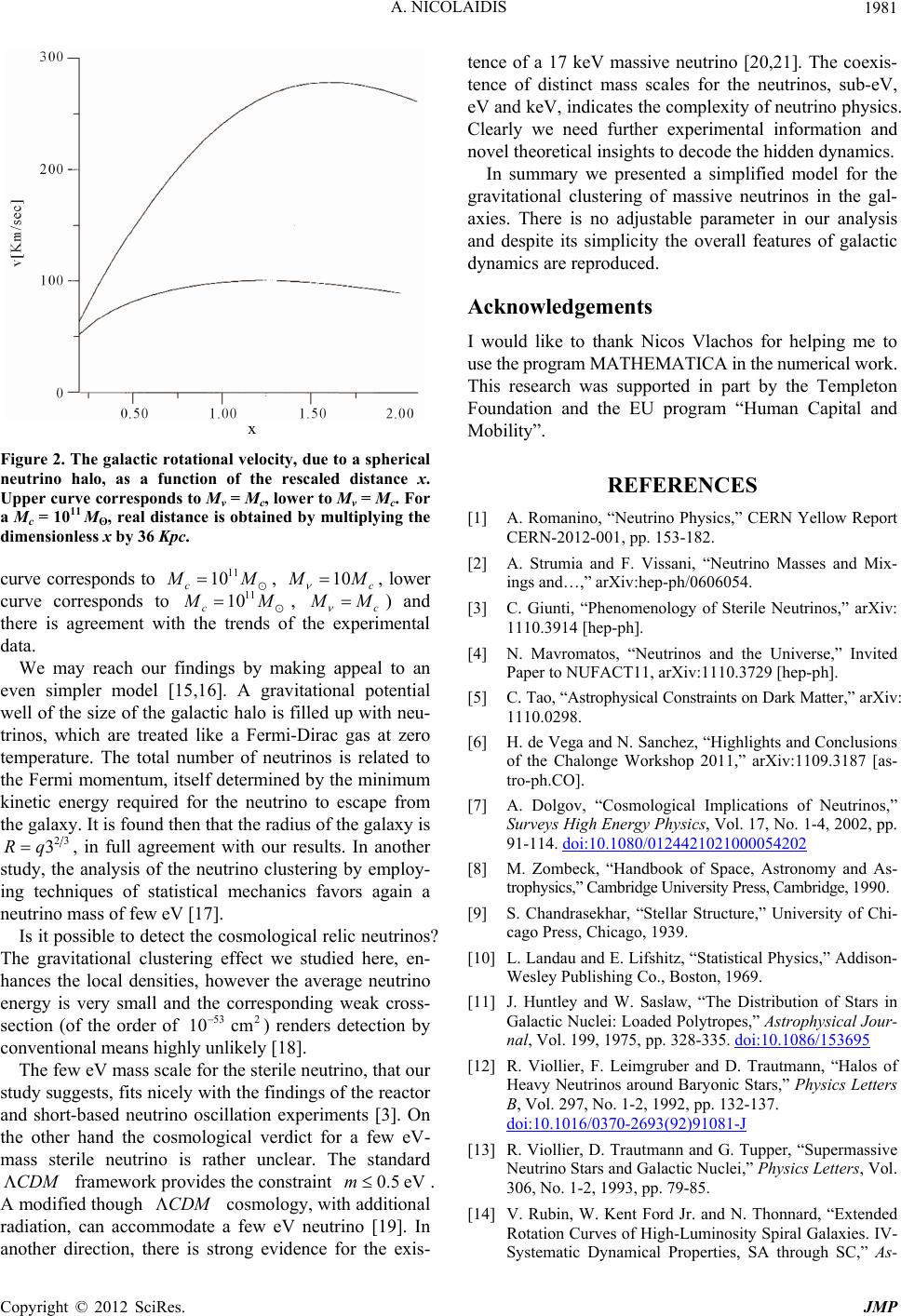
A. NICOLAIDIS 1981
x
Figure 2. The galactic rotational velocity, due to a spherical
neutrino halo, as a function of the rescaled distance x.
Upper curve corresponds to Mv = Mc, lower to Mv = Mc. For
a Mc = 1011 Mʘ, real distance is obtained by multiplying the
dimensionless x by 36 Kpc.
curve corresponds to 11
10
c
M, 10 c
M
, lower
curve corresponds to 11
10
c
M, c
M
) and
there is agreement with the trends of the experimental
data.
We may reach our findings by making appeal to an
even simpler model [15,16]. A gravitational potential
well of the size of the galactic halo is filled up with neu-
trinos, which are treated like a Fermi-Dirac gas at zero
temperature. The total number of neutrinos is related to
the Fermi momentum, itself determined by the minimum
kinetic energy required for the neutrino to escape from
the galaxy. It is found then that the radius of the galaxy is
23
3Rq
53 2
10 cm
CDM0.5 eVm
, in full agreement with our results. In another
study, the analysis of the neutrino clustering by employ-
ing techniques of statistical mechanics favors again a
neutrino mass of few eV [17].
Is it possible to detect the cosmological relic neutrinos?
The gravitational clustering effect we studied here, en-
hances the local densities, however the average neutrino
energy is very small and the corresponding weak cross-
section (of the order of ) renders detection by
conventional means highly unlikely [18].
The few eV mass scale for the sterile neutrino, that our
study suggests, fits nicely with the findings of the reactor
and short-based neutrino oscillation experiments [3]. On
the other hand the cosmological verdict for a few eV-
mass sterile neutrino is rather unclear. The standard
framework provides the constraint
.
A modified though cosmology, with additional
radiation, can accommodate a few eV neutrino [19]. In
another direction, there is strong evidence for the exis-
tence of a 17 keV massive neutrino [20,21]. The coexis-
tence of distinct mass scales for the neutrinos, sub-eV,
eV and keV, indicates the complexity of neutrino physics.
Clearly we need further experimental information and
novel theoretical insights to decode the hidden dynamics.
In summary we presented a simplified model for the
gravitational clustering of massive neutrinos in the gal-
axies. There is no adjustable parameter in our analysis
and despite its simplicity the overall features of galactic
dynamics are reproduced.
Acknowledgements
I would like to thank Nicos Vlachos for helping me to
use the program MATHEMATICA in the numerical work.
This research was supported in part by the Templeton
Foundation and the EU program “Human Capital and
Mobility”.
REFERENCES
[1] A. Romanino, “Neutrino Physics,” CERN Yellow Report
CERN-2012-001, pp. 153-182.
[2] A. Strumia and F. Vissani, “Neutrino Masses and Mix-
ings and…,” arXiv:hep-ph/0606054.
[3] C. Giunti, “Phenomenology of Sterile Neutrinos,” arXiv:
1110.3914 [hep-ph].
[4] N. Mavromatos, “Neutrinos and the Universe,” Invited
Paper to NUFACT11, arXiv:1110.3729 [hep-ph].
[5] C. Tao, “Astrophysical Constraints on Dark Matter,” arXiv:
1110.0298.
[6] H. de Vega and N. Sanchez, “Highlights and Conclusions
of the Chalonge Workshop 2011,” arXiv:1109.3187 [as-
tro-ph.CO].
[7] A. Dolgov, “Cosmological Implications of Neutrinos,”
Surveys High Energy Physics, Vol. 17, No. 1-4, 2002, pp.
91-114. doi:10.1080/0124421021000054202
[8] M. Zombeck, “Handbook of Space, Astronomy and As-
trophysics,” Cambridge University Press, Cambridge, 1990.
[9] S. Chandrasekhar, “Stellar Structure,” University of Chi-
cago Press, Chicago, 1939.
[10] L. Landau and E. Lifshitz, “Statistical Physics,” Addison-
Wesley Publishing Co., Boston, 1969.
[11] J. Huntley and W. Saslaw, “The Distribution of Stars in
Galactic Nuclei: Loaded Polytropes,” Astrophysical Jour-
nal, Vol. 199, 1975, pp. 328-335. doi:10.1086/153695
[12] R. Viollier, F. Leimgruber and D. Trautmann, “Halos of
Heavy Neutrinos around Baryonic Stars,” Physics Letters
B, Vol. 297, No. 1-2, 1992, pp. 132-137.
doi:10.1016/0370-2693(92)91081-J
[13] R. Viollier, D. Trautmann and G. Tupper, “Supermassive
Neutrino Stars and Galactic Nuclei,” Physics Letters, Vol.
306, No. 1-2, 1993, pp. 79-85.
CDM[14] V. Rubin, W. Kent Ford Jr. and N. Thonnard, “Extended
Rotation Curves of High-Luminosity Spiral Galaxies. IV-
Systematic Dynamical Properties, SA through SC,” As-
Copyright © 2012 SciRes. JMP